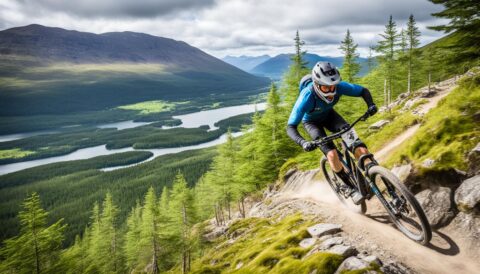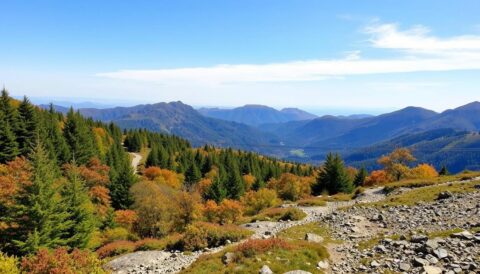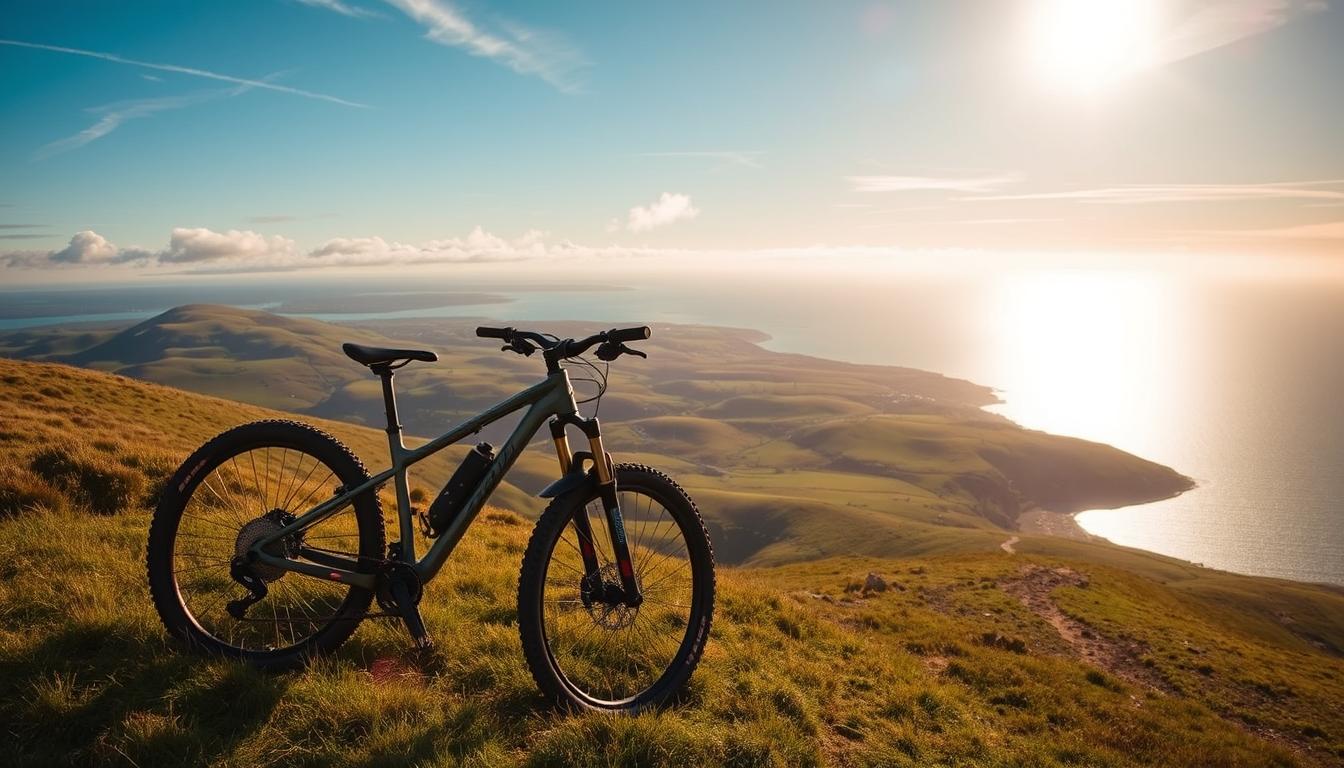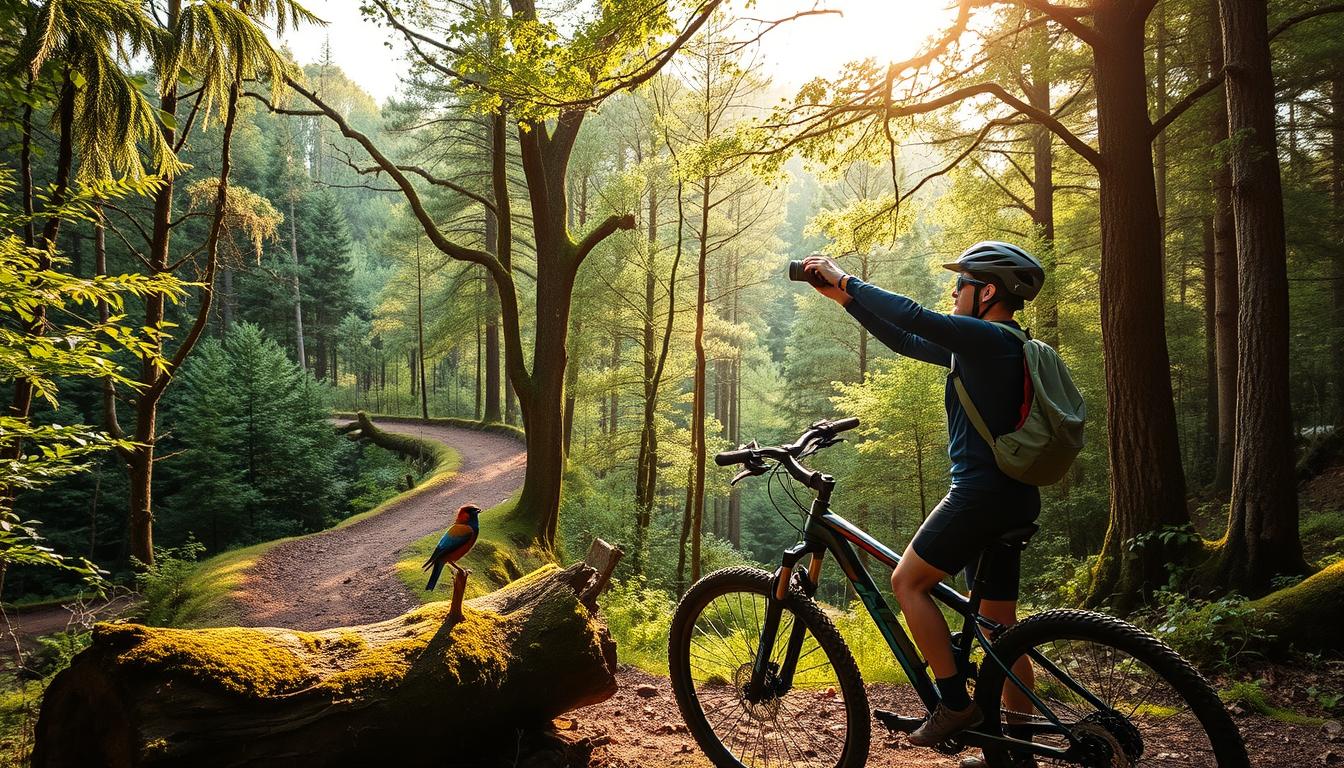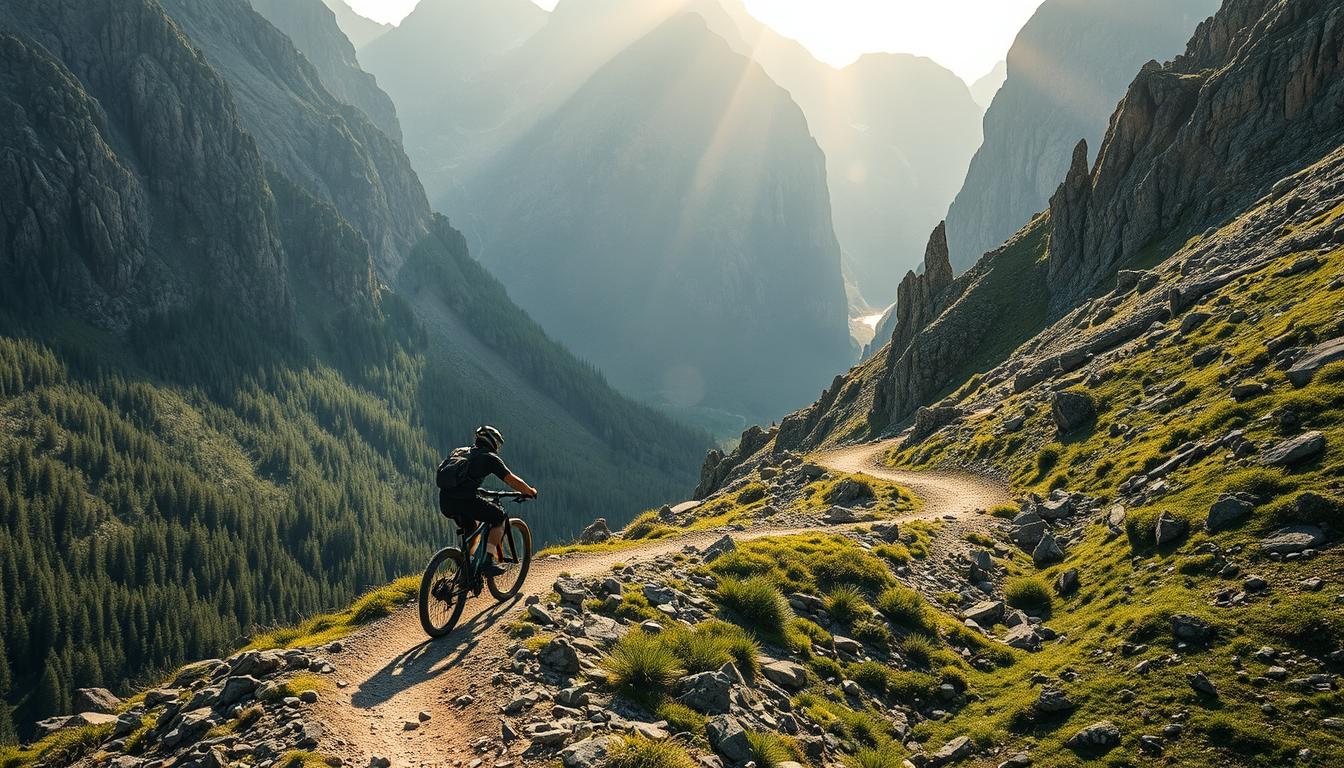Embark on an unforgettable journey across the UK’s diverse landscapes, where thrilling trails and breathtaking views await. Whether you’re a seasoned rider or just starting out, this guide will help you navigate the best routes and choose the right bike for your adventure.
The UK is home to some of the world’s most exhilarating trails, blending natural beauty with purpose-built challenges. From the demanding ascent of Snowdon’s ‘Ranger Path’ to the technical descents of Coed Y Brenin, there’s something for every skill level1. Fort William, renowned for hosting the UCI Mountain Bike World Cup, attracts top riders eager to test their skills1.
Our guide is packed with expert insights, practical advice, and inspiring destinations. Discover the thrill of descending Glentress’s ‘Spooky Wood’ or exploring the flowing trails of Swinley Forest. We’ll help you prepare for the adventure, ensuring you’re equipped with the right bike and knowledge to tackle any route.
- Explore iconic trails across the UK, from beginner-friendly routes to technical challenges.
- Learn how to choose the best mountain bike for your riding style and terrain.
- Gain practical tips on preparation and safety for your next adventure.
Get ready to experience the ultimate mountain biking adventure in the UK. Whether you’re chasing adrenaline or seeking scenic views, this guide has everything you need to conquer the trails with confidence.
Introduction to UK Mountain Bike Adventures
Discover the diverse trails of the UK, where natural beauty meets thrilling challenges. From gentle rides through scenic landscapes to heart-pounding descents, there’s something for every rider. The UK is renowned for its varied terrain, offering both natural trails and purpose-built tracks that cater to all skill levels2.
Setting the Scene for an Epic Ride
The trails in the UK are as varied as the landscapes they traverse. Riders can explore ancient forests, rugged hills, and picturesque valleys. Coed Y Brenin, the first mountain biking centre in the UK, offers a mix of challenging routes and scenic paths2. Similarly, Dalby Forest, which hosted the UCI MTB World Cup in 2011, provides trails that test both skill and endurance2.
Trails in the UK can range from short, family-friendly routes to multi-day adventures. For instance, the Forest of Dean features a 17.5km Family Trail, while the Penmachno Trail spans 19 miles for intermediate riders2. This diversity ensures that whether you’re a beginner or an experienced rider, there’s always a new challenge to conquer.
Understanding the Thrill of Descents
Descents are a highlight of UK mountain biking, offering adrenaline-packed experiences. Singletrack routes, with their narrow paths and technical features, provide a thrilling test of skill and nerve. These routes often include rocky sections, tight turns, and challenging passes that keep riders engaged and excited.
“The thrill of a well-crafted descent is unmatched. It’s where every turn, every rock, and every drop comes together to create an unforgettable experience.”
Notable locations like Fort William and Swinley Forest are famous for their demanding descents and flowing trails. Fort William, known for hosting the UCI Mountain Bike World Cup, attracts top riders eager to test their skills3. Swinley Forest, with its mix of challenging and easy paths, offers something for every rider2.
Planning your rides around seasonal and regional features is key to making the most of your adventure. Late spring to early autumn is the best time for mountain biking in the UK, with trails offering optimal conditions for both speed and control2.
Riders can also explore hidden gems like the 7stanes Mountain Biking Centres in Scotland, which provide trails across various terrains suitable for all skill levels2. The Nidderdale Greenway, a 4-mile easy path, is ideal for families and beginners, while more experienced riders can tackle the challenging trails of Afan Forest Park2.
With such a wide range of trails and the constant evolution of the sport, the UK remains a top destination for mountain bikers. Whether you’re chasing adrenaline or seeking scenic views, the UK’s trails promise an epic ride every time.
Essential Rider Preparation for Mountain Biking the UK’s Iconic Peaks
Preparing for a mountain biking adventure in the UK’s iconic peaks requires a blend of physical fitness, technical skill, and mental readiness. Whether tackling challenging descents or long day rides, being well-prepared is crucial for a safe and enjoyable experience.
Physical and Technical Readiness
A strong physical foundation is essential for tackling the UK’s demanding trails. Riders should focus on building cardiovascular endurance and muscle strength through regular training. Incorporating exercises like cycling, running, and strength training can significantly improve stamina and overall performance on the bike4.
Technical skills are just as important as physical fitness. Practicing bike handling techniques, such as cornering, braking, and maneuvering obstacles, can make a huge difference on the trails. Riders should also familiarize themselves with their bike’s components and learn basic maintenance skills to handle repairs on the go5.
Protective equipment is a must for every ride. A good helmet, gloves, and appropriate padding can prevent injuries in case of a fall. Additionally, a pre-ride warm-up and stretching routine can help prevent muscle strain and improve flexibility4.
Mental preparation is often overlooked but is vital for long and challenging rides. Staying focused, managing fear, and maintaining a positive attitude can make the difference between a successful ride and an early end to the day. Experienced riders often emphasize the importance of mental toughness in overcoming difficult sections5.
Proper preparation not only enhances the riding experience but also reduces the risk of injuries. By combining physical training, technical practice, and mental preparation, riders can approach even the most challenging trails with confidence and enjoyment.
Remember, preparation is key to a successful and enjoyable mountain biking adventure. With the right approach, you’ll be ready to conquer the UK’s iconic peaks with confidence.
Selecting the Best Mountain Bike for Challenging Descents
Choosing the right mountain bike is crucial for tackling tough descents, as it directly impacts your control, confidence, and overall performance. Whether you’re navigating rocky trails or technical routes, a well-suited bike can make all the difference.
Key Features and Rider Considerations
A full-suspension bike is ideal for challenging descents, offering superior comfort and control. Look for models with suspension travel between 140-180 mm, which is perfect for Enduro and All-Mountain rides6. The frame geometry should provide stability at high speeds, while tyre grip ensures traction on rocky surfaces.
| Model | Suspension Travel (mm) | Weight (kg) | Price (£) |
|---|---|---|---|
| Polygon Xtrada 5 | 120 (Front) | 14.31 | 1,200 |
| Calibre Line T3-27 | 140 (Front) | 14.52 | 999 |
| Specialized Stumpjumper | 150 (Front), 145 (Rear) | 13.98 | 2,500 |
When choosing a bike, consider your skill level and the type of trails you’ll ride. For instance, the Specialized Stumpjumper is a great choice for experienced riders, offering 150 mm front suspension and 145 mm rear suspension7. For those on a budget, the Calibre Line T3-27 is an excellent option, priced at £999 with a Go Outdoors membership7.
A well-chosen bike can significantly enhance your riding experience, providing the confidence and control needed for challenging descents. Always opt for a bike that matches your riding style and the terrain you frequent.
Overview of Leading UK Downhill Destinations
Discover the UK’s top downhill destinations, each offering unique trails and breathtaking scenery. From the rugged Scottish Highlands to the picturesque Welsh valleys, these locations cater to both seasoned riders and newcomers.
Highlights from Scotland, Wales, and England
Scotland’s Fort William stands out as a world-class destination, hosting the UCI Mountain Bike World Cup. Its challenging tracks attract top riders, with the fastest recorded time this year being 4 minutes and 37 seconds8.
Wales boasts the Dyfi Forest’s ClimachX descent, one of the longest trail centre descents, offering a thrilling 15-kilometer round trip graded red for its challenging nature9.
England’s Lake District is home to the Warnscale descent, part of the Four Passes ride, known for its challenging terrain requiring concentration and strength8.
| Location | Key Features | Why It’s Popular |
|---|---|---|
| Fort William | World Cup DH Track, gondola lift | Challenging tracks, fast times |
| Lake District | Warnscale descent, part of Four Passes | Scenic, demanding terrain |
| Dyfi Forest | ClimachX descent, 15km red trail | Long, thrilling descent |
These destinations offer a mix of natural beauty and technical challenges, making them must-visit spots for any downhill enthusiast. For more on bike parks with uplift services, visit this guide.
Iconic Trails and Their Unique Characteristics
Explore some of the UK’s most iconic trails, each offering a unique blend of natural beauty and technical challenges. From the South Downs Way to the challenging routes of Jacobs Ladder, these trails cater to all skill levels and riding styles.
The South Downs Way is a standout, offering a 100-mile route that’s fully traversable by bike, with hundreds of tracks and trails to explore10. For those seeking shorter adventures, Cannock Chase provides the 7-mile ‘Follow the Dog’ trail and the 14-mile ‘Monkey Trail’, each with its own set of challenges and rewards10.
Jacobs Ladder is another must-ride, a 17.5-mile highly technical trail that demands both fitness and skill10. The Nan Bield Pass, spanning 35 kilometers, offers a challenging second half, even for experienced riders10. Dalby Forest, with trails ranging from 2 to 6 miles for beginners and a 6.5 km black-rated World Cup Course, ensures there’s something for everyone10.
These trails are celebrated for their combination of natural beauty and technical challenge, making them a cornerstone of the UK’s mountain biking community. Whether you’re a seasoned pro or just starting out, each trail contributes to an unforgettable adventure.
For more information on these and other iconic trails, visit this guide to plan your next ride.
Trail Design and Flow: Natural Versus Built Descent
When it comes to trail design, the debate between natural landscapes and purpose-built tracks is ongoing. Each offers a unique experience, shaping the flow and challenge of a ride.
Comparing Natural Landscapes and Purpose-Built Tracks
Natural trails, like those found in the South Downs Way, often feature unpredictable terrain with rocks, roots, and varying surfaces11. These trails can be less predictable, offering a raw, immersive experience that challenges riders’ adaptability. In contrast, purpose-built tracks, such as those at Cardinham Woods, are engineered for specific flow and features, providing a more controlled environment with man-made obstacles and berms12.
The design of trails significantly impacts the riding experience. Natural trails tend to have a more erratic flow, with sudden changes in elevation and surface conditions. This unpredictability can make for a thrilling, if sometimes challenging, ride. Built trails, on the other hand, are designed with flow in mind, featuring smooth transitions between features like jumps and turns. These trails often include berms and other man-made features that allow riders to maintain speed and control.
Examples from popular UK locations highlight these differences. For instance, the South Downs Way offers a natural, rugged experience with its undulating terrain and varied surfaces11. In contrast, purpose-built tracks like those at Parkwood Springs provide a more structured and predictable ride, with features designed to test specific skills12.
When choosing between natural and built trails, it’s important to consider your riding style and skill level. Natural trails may appeal to those who enjoy a more raw, challenging experience, while built trails are ideal for riders looking for a controlled environment to practice specific techniques.
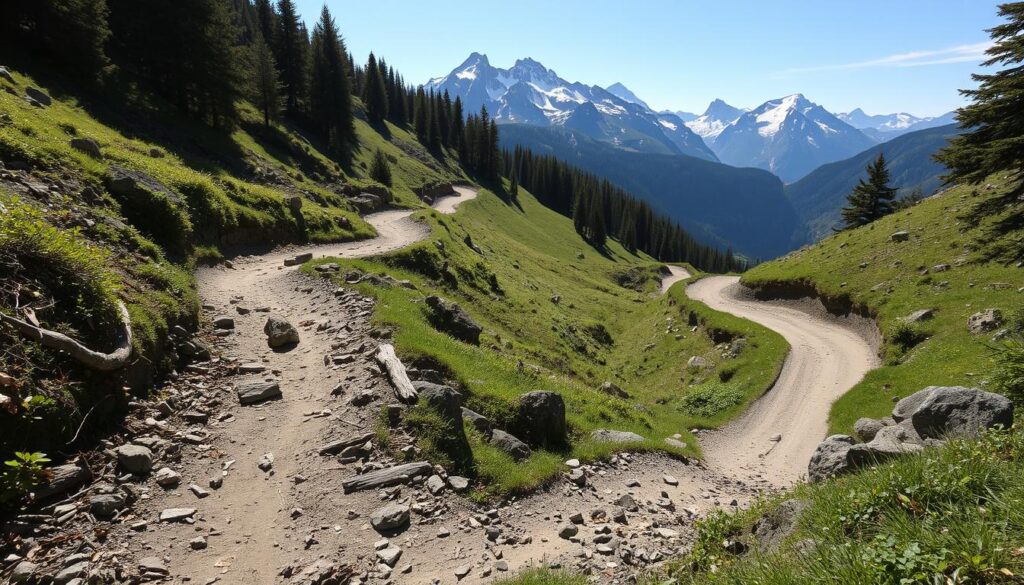
Pro Tips for Tackling Technical Descents
Mastering technical descents is a cornerstone of mountain biking. Whether you’re navigating rocky sections or launching into jumps, confidence and technique are key. Let’s dive into expert tips to help you conquer these challenges with ease.
Handling Rocky Sections and Jumps
When approaching rocky terrain, maintain a central body position over the bike. This lowers your center of gravity, enhancing stability. Keep your elbows slightly bent to absorb shocks and your eyes focused on the line ahead. For jumps, ensure you preload by crouching slightly before the takeoff, then push down on the bars to lift the front wheel. This technique ensures a smooth, controlled launch13.
Mastering Berms and Switchbacks
Berms and switchbacks require precision. Enter berms at an angle, leaning your bike into the turn. Apply gentle, consistent braking before the berm to control speed. For switchbacks, look where you want to go and make sharp, deliberate turns. Keep your weight slightly back to maintain traction on the rear wheel14.
Practice is key. Start with smaller features and gradually move to more challenging ones. Remember, technique can turn a daunting descent into an exhilarating experience.
The Role of Elevation and Geography in UK Trails
Elevation and geography play a crucial role in shaping the nature of UK trails, creating a diverse landscape that challenges and inspires riders. From the rugged highlands to the rolling countryside, these geographical features influence both the technical aspects and the aesthetic appeal of the trails.
Rugged Highlands and Rolling Countryside
The contrast between rugged highland terrains and the rolling countryside is stark. Scotland’s Highlands, with their dramatic elevation changes, offer trails that demand both skill and physical effort. In contrast, the rolling hills of southern England provide gentler, more flowing routes. The Lake District exemplifies this blend, with its scenic valleys and elevated passes offering varied riding experiences15.
Regional Trail Variations: Scotland, Wales, and England
Regional variations significantly impact trail design and ride quality. Scotland’s Highlands are known for their steep, rocky descents, while Wales offers a mix of flowing singletrack and challenging technical sections. England’s trails, such as those in the Peak District, balance natural obstacles with scenic viewpoints, enhancing the riding experience15.
| Region | Key Features | Popular Trails |
|---|---|---|
| Scotland | Steep descents, rocky terrain | Fort William, Cairngorms |
| Wales | Mix of singletrack and technical sections | Dyfi Forest, Coed Y Brenin |
| England | Natural obstacles, scenic viewpoints | Lake District, Peak District |
Understanding the landscape is key to safer and more enjoyable riding. Adapting techniques to different geographical settings ensures that riders can fully appreciate the unique challenges and beauty each region offers15.
Discovering Hidden Gems in Local Trail Networks
Venturing off the beaten path can lead to some truly unforgettable rides. Local trail networks often hide secret routes that are just waiting to be explored.
These lesser-known trails offer a unique riding experience, blending natural beauty with challenging features. For example, the singletrack routes in Dalby Forest provide a thrilling adventure through scenic woodlands16. Similarly, Cannock Chase boasts a variety of trails, from easy family rides to more technical routes, all set in picturesque surroundings16.
Exploring these local networks not only provides a change of scenery but also supports local communities. Many of these trails are maintained by passionate volunteers who ensure they remain accessible and enjoyable for all riders. Plus, discovering these hidden gems often means fewer crowds, allowing for a more immersive experience.
To find these secret spots, consider reaching out to local biking groups or using online forums. Many communities share their favourite routes and tips on how to navigate them. Some popular hidden gems include the trails at Haldon Forest, known for their all-weather conditions, and the challenging routes at Coed Y Brenin, the first purpose-built mountain bike trail in the UK16.
So, next time you’re planning a ride, consider exploring beyond the well-known destinations. These local trail networks offer a chance to discover new thrills and connect with nature in a more personal way.
Best Practices for Safety and Control on Descents
Mastering the art of safe and controlled descents is essential for any mountain biker. Whether you’re navigating steep technical trails or flowing downhill routes, the right combination of gear and technique ensures a safer and more enjoyable ride.
Essential Gear and Protective Equipment
A good helmet is your first line of defence. Opt for a MIPS-equipped helmet, like the Giant Rail SX MIPS, which offers superior protection against oblique impacts17. Pair this with durable knee pads and gloves to safeguard against scrapes and bruises. These essentials are non-negotiable for serious descents.
- Helmet: Choose a MIPS or similar technology for added safety.
- Knee Pads: Opt for pads with durable materials and secure fit.
- Gloves: Select gloves with padding and grip for better control.
Investing in quality gear is an investment in your safety and confidence on the trails.
Techniques for Maintaining Control at Speed
Body positioning is key. Keep your weight centred over the bike, with knees slightly bent to absorb shocks. This lowers your centre of gravity, enhancing stability. When braking, use both brakes evenly, avoiding sudden movements that could destabilise the bike.
- Body Positioning: Stay centred and balanced.
- Braking: Apply gentle, consistent pressure on both brakes.
Practice these techniques on easier trails to build muscle memory and confidence for more challenging descents.
Regular equipment checks are vital. Ensure your brakes are functioning properly and your tyre pressure is optimal for the terrain. A well-maintained bike handles better, especially at speed. Preparation is your best ally on the trails.
Rider Experiences and Reviews of Descent Trails
Mountain bikers across the UK have shared their thrilling experiences on various descent trails, creating a vibrant community of shared knowledge and passion. These firsthand accounts provide valuable insights for both new and seasoned riders.
Insights from the Mountain Biking Community
Renowned rider, Steve Peat, once said, “Every descent tells a story, and each story is unique.” This sentiment resonates deeply within the mountain biking community, where riders often share their adventures and tips through forums and social media groups. Online platforms like MBUK and local biking clubs are treasure troves of information, offering detailed reviews and route recommendations18.
Riders often highlight the thrill and challenge of descents, with many emphasizing the fun factor. For instance, the Helvellyn and Sticks Pass route is frequently praised for its steep climbs and fast descents, making it a must-ride for many18. Similarly, the Ullswater loop, an 8-mile technical singletrack, is a favorite among those seeking a mix of challenge and scenic beauty18.
- Rider Reviews: Many have noted the Cut Gate Path in the Peak District as a challenging yet rewarding route, while The Beast offers a less demanding option for those still building their skills18.
- Community Feedback: Feedback from riders has led to improvements in trail design, with features like water bars becoming more common to test climbing skills19.
These shared experiences not only help new riders choose the best routes but also contribute to the continuous improvement of trail networks. Whether it’s the Kinlochleven Ciaran Path, awarded Trail of the Year in 2009, or the demanding descents in the Scottish Highlands, each trail has its own unique charm and challenges18.
In conclusion, the mountain biking community thrives on shared experiences and collective growth. By leveraging rider reviews and feedback, new and experienced riders alike can discover the best trails and enjoy the thrill of the ride.
Navigating through Iconic Locations: From Fort William to Brechfa
From the rugged trails of Fort William to the serene charm of Brechfa, the UK offers a diverse array of iconic locations for mountain biking enthusiasts. Each destination provides unique challenges and breathtaking views, catering to riders of all skill levels.
Exploring Fort William and Its Famous Downhills
Fort William, located near Ben Nevis, the UK’s highest peak at 1,345 meters, is a world-renowned destination for mountain bikers20. The area is famous for its challenging descents, including the Ranger Path, which offers a mix of technical sections and stunning views. Riders can enjoy the thrill of a 4-minute and 37-second descent, a record time set during the UCI Mountain Bike World Cup20.
Discovering the Charm of Brechfa and Other Locations
Brechfa, located in Wales, offers a blend of natural beauty and technical challenges. The Gorlech trail is known for its demanding terrain, while the Raven trail provides a more flowing ride, making Brechfa a must-visit for riders seeking variety. The area’s scenic landscapes and well-maintained trails attract enthusiasts from across the UK20.
| Location | Key Features | Popular Trails |
|---|---|---|
| Fort William | Challenging descents, technical sections | Ranger Path, World Cup Track |
| Brechfa | Natural charm, varied terrain | Gorlech, Raven Trail |
Both Fort William and Brechfa cater to different riding styles and preferences. Whether you’re seeking adrenaline-pumping descents or scenic rides, these locations offer unforgettable experiences. Plan your route in advance and take advantage of available GPS downloads to navigate these iconic trails with confidence.
- Fort William: Ideal for experienced riders seeking technical challenges.
- Brechfa: Suitable for all skill levels, with trails ranging from moderate to difficult.
These destinations continue to inspire the UK’s mountain biking community, offering a mix of natural beauty and thrilling descents that make every ride memorable.
Integrating Technology: GPS Downloads and Route Mapping
Modern technology has revolutionised the way we plan and navigate mountain biking routes, offering unparalleled convenience and precision. By leveraging digital tools, riders can enhance their riding experience, ensuring safety and efficiency on the trails.
Using Digital Tools to Enhance Your Ride
GPS downloads and route mapping have become essential for mountain bikers. These tools allow riders to plan detailed routes, track their progress, and discover new trails with ease. For instance, komoot offers personalised route planning, enabling riders to filter options by distance and difficulty, while also providing offline navigation for areas with limited internet access21.
Strava, another popular platform, transforms local routes into competitive virtual racetracks through its King/Queen of the Mountains (KOM/QOM) segments. This feature not only adds a fun element to rides but also encourages riders to improve their performance22.
| Tool | Key Features | Benefits |
|---|---|---|
| Komoot | Personalised routing, offline maps, sport-specific tracks | Enhanced route planning, real-time updates, offline accessibility |
| Strava | KOM/QOM segments, competitive tracking, route creation | Performance tracking, community engagement, route sharing |
| Ride with GPS | Route recording, turn-by-turn navigation, offline maps | Detailed route planning, easy sharing, navigation assistance |
Digital mapping not only highlights technical sections and landmarks but also provides real-time updates on track conditions, ensuring riders are well-prepared for their adventures. These tools promote safety and efficiency, allowing riders to focus on enjoying their journey while staying informed.
Embrace technology to elevate your mountain biking experience. Use these digital tools to plan your next adventure, track your progress, and discover new trails with confidence. Happy riding!
Exploring mountain biking the UK’s iconic peaks
Mountain biking in the UK offers a thrilling blend of natural beauty and technical challenges, making it a paradise for riders of all levels. From the rugged trails of Fort William to the serene charm of Brechfa, each location provides a unique experience that captivates riders23.
The UK’s trail network is diverse, with routes like the South Downs Way offering 100 miles of scenic trails, while more challenging descents in the Lake District test even the most experienced riders23. Preparation is key, with the right equipment and techniques ensuring a safe and enjoyable adventure.
Exploring local trail networks and hidden gems can reveal secret routes, such as those in Dalby Forest, which offer a mix of natural beauty and technical features23. These lesser-known trails provide a chance to connect with nature and enjoy a more immersive experience.
For those seeking inspiration, England’s coastal MTB trails offer stunning views and thrilling rides. The UK’s biking culture is vibrant, with a strong community spirit that continues to inspire new adventures.
Whether you’re chasing adrenaline or scenic views, the UK’s trails promise unforgettable experiences. Consider your next adventure as part of this legendary biking culture and embrace the ongoing excitement that defines it.
Planning Your Next Mountain Biking Adventure in the UK
Planning your next mountain biking adventure in the UK is an exciting endeavor, with a wealth of trails and events to explore. Whether you’re a seasoned rider or just starting out, proper preparation is key to making the most of your experience.
Seasonal Strategies and Local Event Tips
The UK’s trail conditions vary by season, so timing your rides can make a big difference. Spring and early autumn often offer the best trail conditions, with minimal mud and optimal grip24. Summer can be busy, so consider visiting popular spots like BikePark Wales during weekdays for a quieter experience.
Local events and gatherings are a great way to meet fellow riders and learn about new trails. For instance, BikePark Wales regularly hosts events and offers guided rides, making it a top choice for both beginners and experienced riders24. The Lake District also features guided mountain bike holidays, including a 7-day tour starting from £1,895.00 per person24.
When planning your route, consider using tools like komoot for personalized routing and offline navigation. This can help you discover hidden gems like the Sandstone Way, a scenic route across Northumberland24. Always download GPS routes in advance to ensure you stay on track, especially in areas with limited internet access.
For those seeking a mix of challenge and scenery, the Silurian Way in Grizedale is an excellent choice, suitable for all skill levels25. Remember to book popular bikeparks like BikePark Wales in advance, as they can get busy, especially during peak seasons.
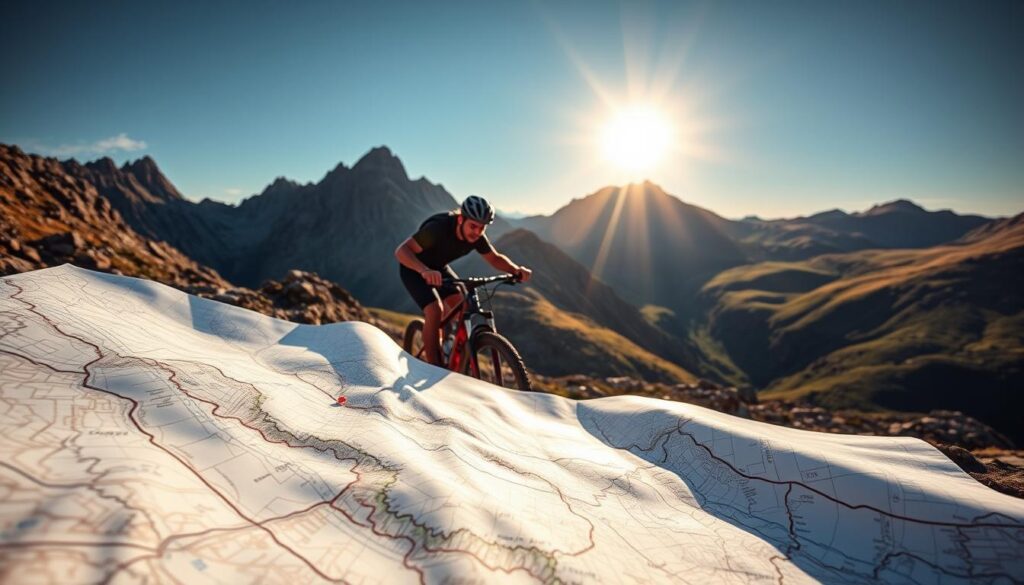
Before heading out, create a checklist to ensure you have all essentials: a well-maintained bike, proper gear, and a first-aid kit. Time management is crucial, so plan your route according to your fitness level and the trail’s difficulty. For longer rides, consider the duration and any necessary stops.
Lastly, stay inspired by exploring new locations and trails. Whether it’s the challenging descents of Revolution Bike Park or the serene trails of Swinley Forest, each destination offers a unique experience. Happy planning, and enjoy your next adventure!
Conclusion
As we conclude this journey through the UK’s iconic trails, it’s clear that the blend of adventure, technical challenge, and scenic beauty makes this a paradise for every rider. From the rugged descents of Fort William to the serene trails of Brechfa, each location offers a unique experience that captivates riders26.
Proper preparation, the right equipment, and a keen enthusiasm are key to unlocking the full potential of these trails. Whether you’re a seasoned rider or just starting out, revisiting this guide will provide the insights needed to plan your next adventure with confidence.
The UK’s trail network continues to evolve, with community feedback playing a vital role in shaping new routes and maintaining existing ones. This collaborative spirit ensures that riders always have access to exciting, well-maintained trails that cater to all skill levels.
The mountain biking community in the UK is both friendly and supportive, offering a wealth of knowledge and camaraderie. By engaging with local groups and sharing experiences, riders can discover hidden gems and contribute to the growth of the sport.
As you embark on your next adventure, remember that every trail tells a story. With the right mindset and preparation, each ride becomes an opportunity to explore, learn, and connect with nature. Stay curious, keep riding, and let the trails inspire you.
We hope this guide has been your trusted companion in planning unforgettable rides. Share your experiences, provide feedback, and join the ever-growing community of UK mountain bikers. Together, we continue to shape the future of this exhilarating sport.
FAQ
What makes a mountain bike descent the best?
The best mountain bike descent combines thrilling terrain, flow, and scenic views. Trails like those in Fort William and the Lake District offer challenging routes with stunning landscapes, making them favourites among riders.
How do I choose the right mountain bike for technical descents?
Opt for a bike with a robust frame, good suspension travel, and reliable brakes. Consider models like the Nukeproof Mega for enduro riding or a downhill-specific bike like the Santa Cruz V10 for steep, rocky sections.
What are the top UK destinations for mountain biking?
Scotland’s Fort William is renowned for its downhill tracks, while BikePark Wales in South Wales offers purpose-built trails. England’s Lake District and Whinlatter Forest also provide exceptional riding experiences.
How do I handle rocky sections and jumps?
Start with smaller features to build confidence. Focus on maintaining speed, keeping your weight centred, and using your suspension to absorb impacts. Practise in trail centres like BikePark Wales to hone your skills.
What is the difference between natural and built descents?
Natural descents, like those in the Lake District, offer raw, unspoiled terrain. Built descents, such as the Ranger Path in Whinlatter Forest, are designed for flow and feature man-made jumps and berms.
What safety gear should I wear for mountain biking?
Always wear a helmet, knee pads, and gloves. For more challenging rides, consider additional protection like a back protector or neck roll.
How can I find hidden gems in local trail networks?
Explore local guidebooks, join online forums, or use apps like Trailforks. Riders often share their favourite routes in communities like Singletrack forums.
What are the best techniques for cornering and switchbacks?
Shift your weight to balance the bike, use your inside leg to guide direction, and look where you want to go. Practise on flowing trails like those at BikePark Wales to master these skills.
What is the best time of year for mountain biking in the UK?
The best time is from spring to autumn, when trails are dry and weather is mild. Avoid wet conditions unless you’re prepared with a wet-weather tyre setup.
Source Links
- The 15 Best Places To Mountain Bike In The U.K.
- Discover the Best Mountain Biking Adventures in the UK
- Peak District mountain biking, England
- Useful Information for Mountain Bikers | Peak District MTB
- The Beginner’s Guide To Mountain Biking
- Choosing a Mountain Bike – A Buying Guide | Pauls Cycles Hub
- Best mountain bike 2023: reviewed and rated – MBR
- How many of these epic UK mountain bike descents have you completed? – MBR
- 5 ‘Wheely’ Great UK Holiday Destinations for Mountain Bikers | Independent Cottages
- Best Mountain Biking Trails in the UK | LIOS
- Trail Centres UK – A guide for eMTB riders
- 11 of the best secret trail centres in the UK – MBR
- An MTB Guide to Yr Wyddfa (Snowdon) – RAW Adventures
- The Dark Peak — true northern grit in the Peak District | Mountain Biking Collection by komoot
- Peak District facts: Peak District National Park
- Mountain Biking in the Peak District: Trails and Tips for All Levels
- Best Mountain Bike Helmets UK
- Iconic UK Mountain Biking Routes Every Rider Should Experience
- Mountain Biking Torridon: The Proving Ground for Scottish Riders
- Exploring the Best Mountain Bike Trails in the UK
- Komoot | Find, plan and share your adventures
- The best cycling apps for route-planning and navigation 2025
- Exploring the Best Mountain Bike Trails in the UK
- Mountain Bike Holidays in the UK
- The absolute best places to ride your Mountain Bike in the UK – Pedal Cover
- Explore the Scottish Highlands on Two Wheels WildTrax

